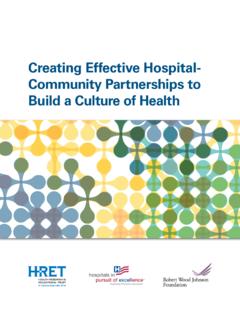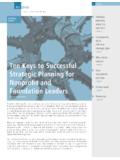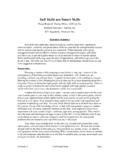Transcription of A Systematic Approach from the Joint Commission …
1 preventing Patient Falls: A Systematic Approach from the Joint Commission Center for transforming Healthcare Project October 2016. preventing Patient Falls 1. Suggested Citation: Health Research & Educational Trust. (2016, October). preventing patient falls: A Systematic Approach from the Joint Commission Center for transforming Healthcare project. Chicago, IL: Health Research & Educational Trust. Accessed at Accessible at: Contact: or (877) 243-0027. 2016 Health Research & Educational Trust. All rights reserved. All materials contained in this publication are available to anyone for download on , or for personal, non-commercial use only. No part of this publication may be reproduced and distributed in any form without permission of the publication or in the case of third party materials, the owner of that content, except in the case of brief quotations followed by the above suggested citation.
2 To request permission to reproduce any of these materials, please email 2 preventing Patient Falls Table of Contents Executive Background ..4. Participating Robust Process Improvement ..5. Top Contributing Factors of Patient Falls and Falls with Fall Risk Assessment Handoff Communication Toileting Call Light Education and Organizational Culture Medication Ensuring Results ..9. Targeted Solutions Tool ..10. Bassett Medical Center, Cooperstown, New Baylor Scott & White Medical Center Garland, Kaiser Permanente Zion Medical Center, San Diego, Memorial Hermann Memorial City Hospital, Houston, Wake Forest Baptist Medical Center, Winston-Salem, North preventing Patient Falls 3. Executive Summary The seven participating hospitals set a goal to reduce the rate of falls with injury on the It is estimated that between 700,000 and designated inpatient units (aggregated) by 1,000,000 people fall in hospitals each 50 percent and to decrease the falls rate From 30 percent to 35 percent of by 25 percent.
3 Organizations began with those patients sustain an injury as a result an aggregate baseline falls with injury rate of the fall, and approximately 11,000 falls of (falls with injury per 1,000 patient are Injuries related to falls can days) and an aggregate baseline falls rate result in an additional hospital days7. of (falls per 1,000 patient days). with the cost for a serious fall with injury averaging $14,056 per ,9 Due to Five of the participating organizations the multitude of factors that play a role submitted data throughout the project in patient falls and falls with injury, most timeline. In aggregate, these organizations successful fall reduction programs have demonstrated a 62 percent reduction in implemented multiple strategies such as the falls with injury rate and a 35 percent improving the fall risk assessment process, reduction in the falls rate.
4 Five other using visual cues or systems to alert staff hospitals have tested the original work with to patients at high risk for falls, improving similar results. communication among staff regarding fall risk status, ensuring safe patient transfers This report describes the types of risks that while toileting, using equipment such as lead to patient falls and falls with injury, low beds and mats, and improving staff the root causes for those risks, and the and patient education. solutions designed to reduce them. Also included are examples and lessons learned As part of the Joint Commission Center for from five of the participating and pilot transforming Healthcare preventing falls health care organizations. The case study with injury project, seven hospitals section highlights individual hospital and started the journey of using Robust system experiences preventing falls with Process Improvement , which incorporates injury.
5 Tools from Lean Six Sigma and change management methodologies, to reduce Background falls with injury on inpatient pilot units Despite long-term and widespread within their organizations. The units chosen attention to fall prevention, patients included four medical-surgical units, one continue to fall, and many of these falls medical oncology unit, a cardiology unit, result in injury. Their experience is not and a medical-surgical/stroke/telemetry unusual. It is estimated that between unit. The project was then pilot tested 700,000 and 1,000,000 people fall in with five additional hospitals in order to hospitals each From 30 percent to 35. validate the measurement system and percent of those patients sustain an injury solutions. Each organization identified the as a result of the fall, and approximately specific factors that led to falls with injury 11,000 falls are Injuries related to and developed solutions targeted to those falls can result in an additional hospital contributing factors.
6 The organizations days,7 with the cost for a serious fall with identified 30 root causes and developed 21. injury averaging $14,056 per ,9 Falls targeted solutions to address those root have been identified by the Centers for causes. The combination of contributing Medicare & Medicaid Services (CMS) as a factors was different for each organization, preventable event that should never occur. leading to different solution sets. 4 preventing Patient Falls While much work has been done in the a cardiology unit, and a medical surgical/. hospital setting, patient falls continue to stroke/telemetry unit. In addition to the be a problem. preventing patient falls seven participating hospitals, the project is a complex issue that requires using was pilot tested with five additional robust methodology to measure all of hospitals to validate the measurement the potential contributing variables and system and solutions.
7 Then analyzing the data to determine the primary contributing factors. This Case studies from five participating and process allows for implementing targeted, pilot hospitals are highlighted in this guide: sustainable improvements. Bassett Medical Center, Cooperstown, Previous articles have suggested that New York focusing interventions on individual Baylor Scott & White Medical Center . components of falls and fall risks has been Garland, Texas unsuccessful in significantly reducing Kaiser Permanente Zion Medical Center, Due to the multitude of factors that San Diego, California play a role in patient falls, most successful Memorial Hermann Memorial City fall reduction programs have implemented Hospital, Houston, Texas simultaneous strategies such as improving Wake Forest Baptist Medical Center, the fall risk assessment process, using Winston-Salem, North Carolina visual cues or systems to alert staff to patients at high risk for falls, improving Robust Process Improvement communication among staff regarding fall The participating hospitals used the RPI.
8 Risk status, ensuring safe patient transfers methodology to identify contributing while toileting, using equipment such as factors and develop solutions to prevent low beds and mats, and improving staff patient falls and falls with injury on their and patient education to successfully designated units. RPI is a fact-based, reduce patient Systematic and data-driven problem- solving methodology that incorporates This project utilized Robust Process tools and concepts from Lean Six Sigma Improvement (RPI ) methodology to and change management in an effort to identify the various contributing factors solve complex problems in health care. for inpatient falls and develop and The participating organizations adhered to validate improvements to achieve the Six Sigma DMAIC (Define, Measure, sustainable results. Analyze, Improve, Control) framework to uncover the contributing factors and root Participating Hospitals causes for falls and falls with injury in their Seven hospitals began participation designated units.
9 In the Joint Commission Center for transforming Healthcare's preventing falls While all types and ages of patients with injury project. Hospital size ranged admitted to a hospital may be at risk for from a 100-bed community hospital to a falls, the scope of this project was limited 1,700-bed academic medical center. Each to adult patients 18 years of age and older participating hospital identified an inpatient who were admitted and discharged from pilot unit for the purposes of this project. the designated pilot units. The process The units chosen included four medical- began when a patient was admitted to surgical units, one medical oncology unit, the unit, and the process ended when the patient physically left the inpatient unit . preventing Patient Falls 5. , for testing, rehabilitation, released Top Contributing Factors of after discharge.
10 Only falls that occurred while the patient was physically on the Patient Falls and Falls designated pilot units were included in with Injury this project and were identified as a fall Five of the seven participating hospitals on the unit, consistent with the National identified and validated contributing Database of Nursing Quality Indicators factors for why patients were falling in (NDNQI) recommendations. their organizations. The top 10 contributing factors conditions identified most For the purposes of this collaborative, a frequently by hospitals for falls and fall was defined as a sudden, unintentional falls with injury were grouped into six descent, with or without injury to the categories: 1) fall risk assessment issues, patient, which resulted in the patient 2) handoff communication issues, 3). coming to rest on the floor, on or against toileting issues, 4) call light issues, 5).

















